AskMe
About
AskMe is a collection of simple scripts to help you study. I don’t know how other people study but I totally have to answer some questions.
As of now, it includes:
- AskMe Multiple Choices (shell script)
- AskMe Memorize (shell script)
- AskMe-dmenu (shell script)
- AskMe Web (memorize) (web app)
- AskMe Web (list memorize) (web app)
- AskMe Web (multiple choices) (web app)
Shell Script Version
Perfect for people who live in the terminal. Questions are written with shell syntax so if you’re comfortable with shell scripting, you should be good to go.
Multiple Choices
AskMe Multiple Choices supports multiple choices, from a to z. The questions are made by declaring functions called q_1, q_2, q_3, and so on. You can set some properties and a title
with the props function.
Here’s an example:
#!askme-multchoices
props()
{
title="My Title"
shuffle_questions=yes
shuffle=yes
wait_duration=1
}
q_1()
{
shuffle=no
question="Your question"
show_correct=yes
choices=("Incorrect answer" "Also incorrect answer" "Correct answer")
answer=3
}
q_2()
{
question="Your second question"
show_correct=no
choices=("True" "False")
answer=1
}
And how it looks like with AskMe:

Memorize
AskMe Memorize is used for memorizing stuff like translations, meanings, etc. To answer, you have to type in the full associated answer. It supports multiple answers, too. Here’s an example:
#!askme-memorize
title="My Title"
subtitle="A quite long subtitle"
show_correct=yes
shuffle=yes
loop=no
wait_duration=".7"
declare -A questions=(
["Cow"]="Moo"
['Cat']='Meow'
['Something']='("correct" "also correct")'
)
And how it looks like:
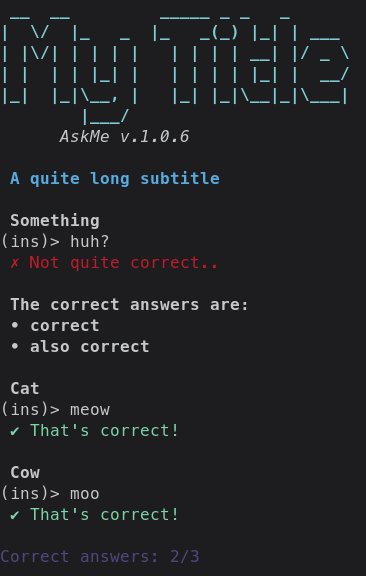
dmenu
AskMe-dmenu is just AskMe Memorize with dmenu.
Sometimes you don’t need to memorize the entire word precisely.. so I wrote AskMe-dmenu which uses dmenu that shows you all the possible choices.
Here’s how it looks like:
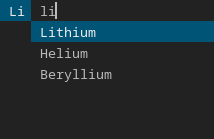
And a GIF showing me using it:

Web App Version
Create a sharable link or embed these mini quiz to your website. Or use it however you want.
Memorize
AskMe Web (memorize) is a port of AskMe Memorize but for browsers. I wrote this so I could embed AskMe to my Notion pages. It has two modes: input mode and dropdown mode. Input mode lets the user to input answers manually, while dropdown mode lets the user to choose answers with dropdown menus.
Here’s an example file:
{
"title": "AskMe Memorize",
"description": "AskMe memorize demo question.",
"list":
[
["Key one", "value one"],
["Key two", "value two"],
["Key three", "value three"],
["Key four", "value four"],
["Key five", "value five"]
]
}
Here’s how it looks like with input mode:
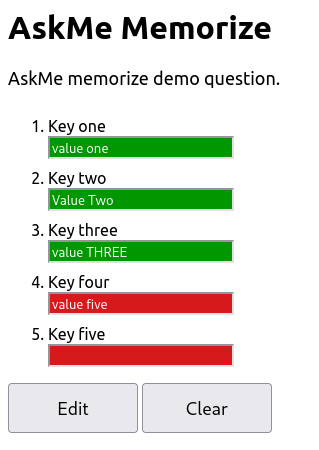
And dropdown mode:
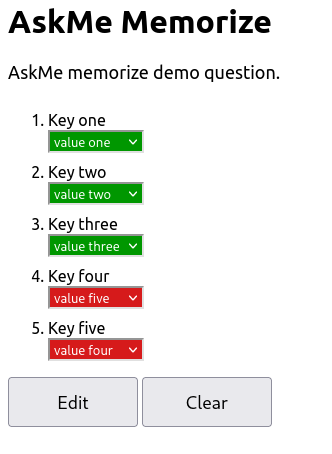
You can host it yourself by getting the source code, or use my instance at daringcuteseal.xyz/software/askme/web/memorize.
List Memorize
Embeddable list memorizer. From a studying survey™ at my class, a lot of my friends apparently “asked themselves” when studying, which is a bad way to memorize something.
Also, check out list-memorize for a based studying experience from the CLI.
Here’s an example file:
{
"title": "An Example Title",
"description": "An example description",
"list":
[
"List one",
"List two",
"List three",
"List four"
]
}
How it looks like:
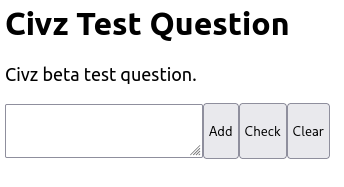
- Use the most left input box to type a string value.
- Use the
Addbutton to add the string from the input box to the list. - Use the
Checkbutton to match your answers with the correct answers. - Use the
Clearbutton to start over.
You can host it yourself by getting the source code, or use my instance at daringcuteseal.xyz/software/askme/web/list-memorize.
Multiple Choices
AskMe Web (multiple choices) is a port of AskMe multiple choices but for browsers.
You can host it yourself by getting the source code, or use my instance at daringcuteseal.xyz/software/askme/web/multchoices.
Here’s an example file:
{
"title": "Multiple Choice Question Test",
"description": "Test questions.",
"list":
[
{
"label": "First question",
"choice":
[
"Not the correct answer",
"The correct answer",
"Not the correct answer too"
],
"correct": 2
},
{
"label": "Second question",
"choice":
[
"The correct answer",
"Not the correct answer too",
"Not the correct answer"
],
"correct": 1
},
{
"label": "Third question",
"choice":
[
"True",
"False"
],
"correct": 1
}
]
}
And how it looks like:
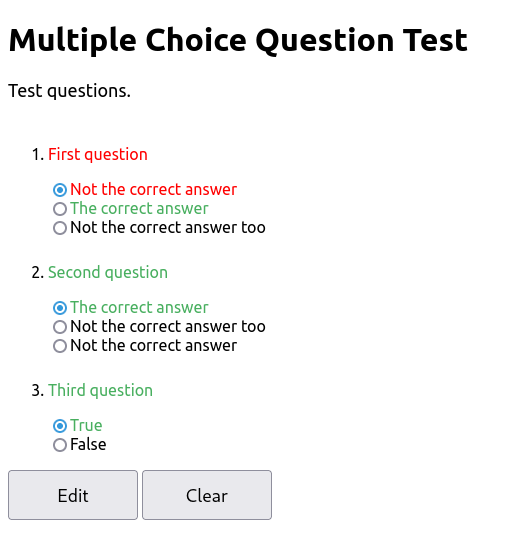
History
The first concept of AskMe came from a little handcrafted shell script I wrote back when I tried to memorize some Sundanese words with its “sounding”. Actually I don’t even understand what that is, but I just have to memorize that 💀 Anyways, it was a simple 64-lined script that asks you a word and expects you to answer the correct associated answer, kinda like a flash card or some sort of that. It was actually even more simple back then, but became too simple for me soon.
A couple days before my mid-term test, I decided to write what now known as “AskMe Multiple Choices”, which is a nicer more sophisticated shell script that supports multiple choices answers. After my mid-term test was done, I really liked my “AskMe Multiple Choices” and decided to write what now known as “AskMe Memorize”, which was a better version of that first 64-lined script. Then, when I had to memorize some Latin/Greek words and its meanings, I found it too hard and unnecessary to memorize the entire thing, so I wrote Askme-dmenu that shows all the available choices.
More info is available at AskMe’s GitHub page.